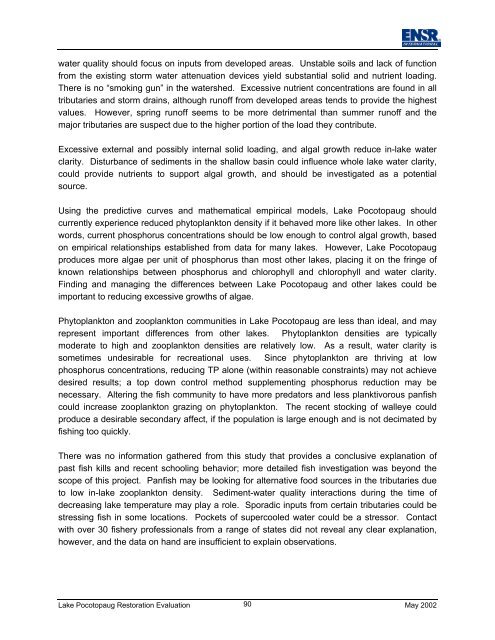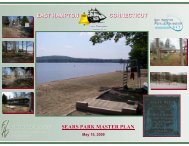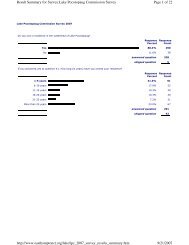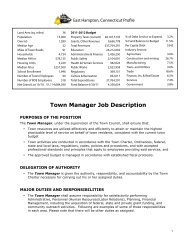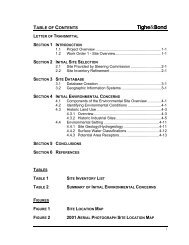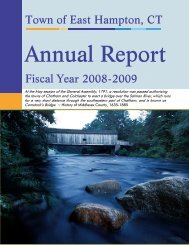Lake Pocotopaug Lake and Watershed Restoration Evaluation ...
Lake Pocotopaug Lake and Watershed Restoration Evaluation ...
Lake Pocotopaug Lake and Watershed Restoration Evaluation ...
Create successful ePaper yourself
Turn your PDF publications into a flip-book with our unique Google optimized e-Paper software.
water quality should focus on inputs from developed areas. Unstable soils <strong>and</strong> lack of functionfrom the existing storm water attenuation devices yield substantial solid <strong>and</strong> nutrient loading.There is no “smoking gun” in the watershed. Excessive nutrient concentrations are found in alltributaries <strong>and</strong> storm drains, although runoff from developed areas tends to provide the highestvalues. However, spring runoff seems to be more detrimental than summer runoff <strong>and</strong> themajor tributaries are suspect due to the higher portion of the load they contribute.Excessive external <strong>and</strong> possibly internal solid loading, <strong>and</strong> algal growth reduce in-lake waterclarity. Disturbance of sediments in the shallow basin could influence whole lake water clarity,could provide nutrients to support algal growth, <strong>and</strong> should be investigated as a potentialsource.Using the predictive curves <strong>and</strong> mathematical empirical models, <strong>Lake</strong> <strong>Pocotopaug</strong> shouldcurrently experience reduced phytoplankton density if it behaved more like other lakes. In otherwords, current phosphorus concentrations should be low enough to control algal growth, basedon empirical relationships established from data for many lakes. However, <strong>Lake</strong> <strong>Pocotopaug</strong>produces more algae per unit of phosphorus than most other lakes, placing it on the fringe ofknown relationships between phosphorus <strong>and</strong> chlorophyll <strong>and</strong> chlorophyll <strong>and</strong> water clarity.Finding <strong>and</strong> managing the differences between <strong>Lake</strong> <strong>Pocotopaug</strong> <strong>and</strong> other lakes could beimportant to reducing excessive growths of algae.Phytoplankton <strong>and</strong> zooplankton communities in <strong>Lake</strong> <strong>Pocotopaug</strong> are less than ideal, <strong>and</strong> mayrepresent important differences from other lakes. Phytoplankton densities are typicallymoderate to high <strong>and</strong> zooplankton densities are relatively low. As a result, water clarity issometimes undesirable for recreational uses. Since phytoplankton are thriving at lowphosphorus concentrations, reducing TP alone (within reasonable constraints) may not achievedesired results; a top down control method supplementing phosphorus reduction may benecessary. Altering the fish community to have more predators <strong>and</strong> less planktivorous panfishcould increase zooplankton grazing on phytoplankton. The recent stocking of walleye couldproduce a desirable secondary affect, if the population is large enough <strong>and</strong> is not decimated byfishing too quickly.There was no information gathered from this study that provides a conclusive explanation ofpast fish kills <strong>and</strong> recent schooling behavior; more detailed fish investigation was beyond thescope of this project. Panfish may be looking for alternative food sources in the tributaries dueto low in-lake zooplankton density. Sediment-water quality interactions during the time ofdecreasing lake temperature may play a role. Sporadic inputs from certain tributaries could bestressing fish in some locations. Pockets of supercooled water could be a stressor. Contactwith over 30 fishery professionals from a range of states did not reveal any clear explanation,however, <strong>and</strong> the data on h<strong>and</strong> are insufficient to explain observations.<strong>Lake</strong> <strong>Pocotopaug</strong> <strong>Restoration</strong> <strong>Evaluation</strong> 90May 2002


